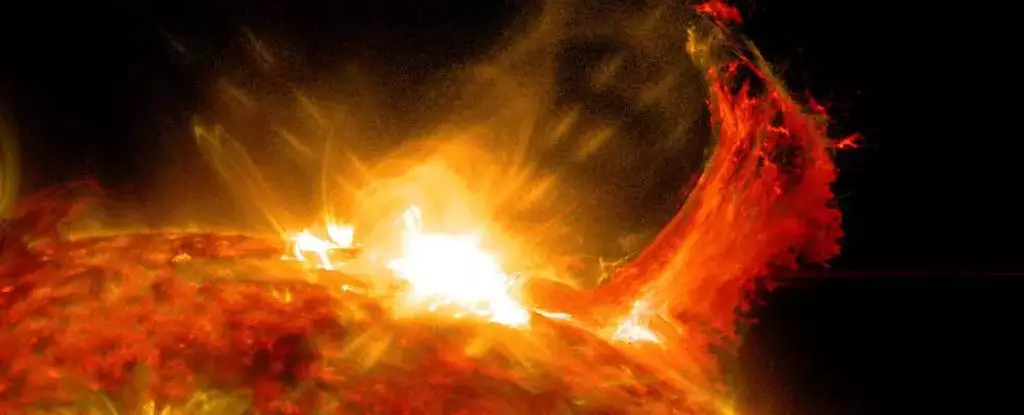The Sun, the central figure of our solar system, may seem like a gentle source of warmth and light from a distance. However, it is anything but peaceful. The solar atmosphere pulsates with relentless activity, including turbulent convection currents and a magnetic field that is in a constant state of flux. These phenomena lead to explosive releases of energy in the form of solar flares and coronal mass ejections (CMEs). While most of these solar events are benign relative to Earth’s stability, occasionally, powerful explosions occur that could pose grave risks to our technological infrastructure.
The scale of these eruptions varies significantly. Historically, astronomers have estimated the frequency of damaging solar flares to be anywhere from once a century to once every thousand years. However, a recent comprehensive study based on observations of over 56,000 stars resembling our Sun implies that we might be in grave danger—superflares could be hitting Earth approximately once every 100 years.
Determining the eruption rates of solar superflares is no simple task. Astronomers lack the means to rewind the cosmic clock and witness past solar events directly. To piece together this puzzle, researchers turn to historical records. Trees have preserved clues, specifically spikes in carbon-14 isotopes linked to solar activity. Similarly, isolated nitrogen signatures in polar ice can also provide insights. Nevertheless, these indirect methods might not fully encapsulate the Sun’s explosive tendencies.
By studying stars that share characteristics with our G-type yellow dwarf—our Sun—researchers sought to observe flaring instances directly. They included stars with unknown rotational rates, deliberately focusing on those that closely matched the Sun’s brightness and thermal properties while excluding faster-rotating younger stars that are generally more active.
The research team identified a striking data set of 56,450 Sun-like stars and documented 2,889 superflares across 2,527 of these celestial bodies. This discovery indicated a compelling superflare rate equivalent to one significant eruptive event every century.
Understanding the correlation between solar events and their potential impact is crucial for safeguarding our technological society. Solar flares and associated coronal mass ejections can disrupt Earth’s magnetic field, posing severe risks. The infamous Carrington Event of September 1859 serves as a historical reference point; the storm sparked havoc globally, disabling telegraphic systems and igniting fires due to overloading circuits.
Additionally, the 1989 geomagnetic storm also brought widespread power outages, demonstrating that solar activity could have immediate and devastating repercussions for modern infrastructure. Experts have mapped out other geomagnetic storms surpassing the Carrington event, known as Miyake events, found embedded within tree rings dating back 15,000 years. These events are believed to occur roughly every millennia, further illustrating the potential scale and implications of solar activity.
Despite extensive research, questions remain about the connection between solar flares and coronal mass ejections. Not every flare results in a CME, and the relationship between the two phenomena is still an evolving area of study. Scientists, including astrophysicist Ilya Usoskin, emphasize the necessity for more research to discern their interactions and the broader implications for solar particle events.
While solar flares can disrupt radio communication temporarily, the broader concern lies in their potential to unleash geomagnetic storms that can have cascading effects on power grids and satellite systems, crippling the technological foundation of our society.
With the Sun’s unpredictable nature posing risks to our delicate infrastructure, enhancing our understanding and prediction capabilities for solar activities becomes essential. Scientists are advocating for continuous monitoring of solar events and improved forecasting methods to mitigate the impacts of solar storms.
Astrophysicist Natalie Krivova advocates for a deeper inquiry into solar behavior, stating that recent findings remind us that extreme solar activity is an inherent part of the Sun’s behavior. The stakes are high, as the modern world relies heavily on technology sensitive to disruptions in our magnetic field produced by solar activity.
As we continue grappling with the mysteries surrounding our Sun, the knowledge acquired can serve as a critical foundation for safeguarding our planet and its inhabitants against cataclysmic solar eruptions. Understanding the precariousness of our star allows for the formulation of strategies to mitigate and adapt to the potential wrath of the Sun. The time to prioritize and invest in solar weather preparedness is now, to ensure we can face the fury of our cosmic neighbor head-on.


Leave a Reply